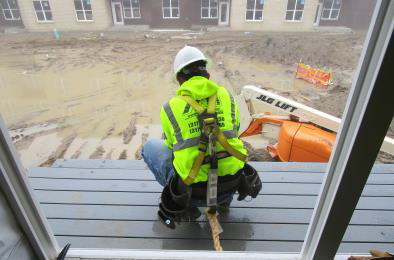
According to a recent article from American Society of Safety Professionals (assp.org), insufficient anchorage strength and inappropriate anchorage connection are two common mistakes made with fall protection equipment. While anchorage connectors are important tools for working at height, they are only effective if used properly.
The article further states that due to the complexity of anchorage connectors, safety professionals and users need to take steps to confirm that the anchorage point selected is strong enough to safely arrest a fall and that the anchorage is at a point that will allow a worker to avoid injury should they fall.
GET TO KNOW ANCHORAGE CONNECTOR TYPES
The first step to using anchorage connectors properly is understanding the different types of connectors and their unique purpose and capabilities.
- TYPE A: An anchorage connector (other than Type T or Type D) designed for an active fall protection system.
- TYPE T: An anchorage connector designed to support a suspended component/tie-back line or for an active fall protection system.
- TYPE D: An anchorage connector designed to allow deformation or movement when arresting a fall with the purpose of absorbing fall energy and reducing the strength requirements of the anchorage to which it is attached. Deformation may be permanent or temporary.
Typically, the anchorage connector itself must have a strength of 5,000 lbs. In some cases, Type D anchorage connectors may not be suitable for work positioning, rescue, rope access and suspended component/tie-back because of their low serviceability rating. Travel restraint may also be acceptable based on the serviceability rating and deformation limits of the individual product.
SELECT APPROPRIATE ANCHOR POINTS
In addition to selecting the right anchorage connector for a particular task, you need to verify that the anchor point is strong enough and placed so it will safely arrest a fall.
To confirm that anchor points are correct for a particular task, a qualified person can certify that an anchor has the minimum required strength.
ANSI/ASSP Z359.18 also requires that:
- A connection point support only one user or system at a time.
- A connection point eye on a Type T anchorage connector be a closed eye with a minimum 1-inch inside radius.
- Except for cinching anchorage connectors, anchorage connectors shall not have closed loops that are not intended for, or could be mistaken for, a connection point.
- Anchorage connectors that include an operate gate, rings, buckles, adjusters or other hardware covered by ANSI/ASSP Z359.12, Connecting Components for Personal Fall Arrest Systems, shall use hardware that complies with the requirements of ANSI/ASSP Z359.12.
- Multiple connection points shall only be permitted on tripod and davit style anchorage connectors.
USE ANCHORAGE CONNECTORS AS DIRECTED
Although a simple step, one critical step you can take to keep workers safe at height is to read and understand the instructions for using anchorage connectors correctly.
Manufacturers can design anchorage connectors to manage the energy of a fall in different ways, so workers need to understand what an anchorage connector has been designed
to do.
Some anchors can screw into soil or metal decking, while others can wrap around trees. These different circumstances leave anchorage connectors open to misuse if workers do not understand how the manufacturer intended them to be used.
Furthermore, while the concept of what anchorage connectors do appear to be simple, they are the most complicated part of the fall protection system.
To read this article in its entirety, please visit assp.org/news: Fall Protection Anchorage: Are You Anchoring Properly?
For more information on Workplace Safety and Training Solutions, check out our
Safety and OSHA Training section!
Do you have a training need or a question for one of our Safety Consultants?
We are here for you – Contact Us.
Check out our Upcoming Networking Events!
Read what our consultants have to say – The Consultant’s Corner.
Make sure to join us for Safety Facts and Snacks. For more information on the schedule of events and registration, visit Safety Facts and Snacks.
08/31//2020
Related Topics: Accident Prevention, Did you know, Fall Protection, Hoist Safety, Jobsite Safety, Safety Articles, Safety Awareness, Safety Tips, Safety Tools